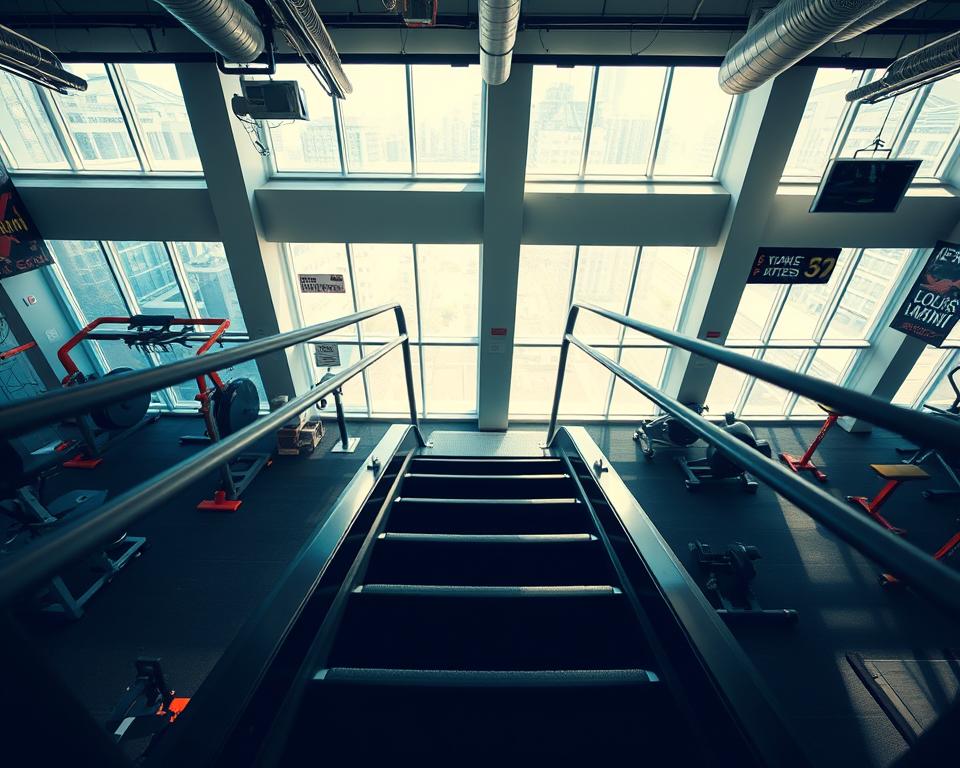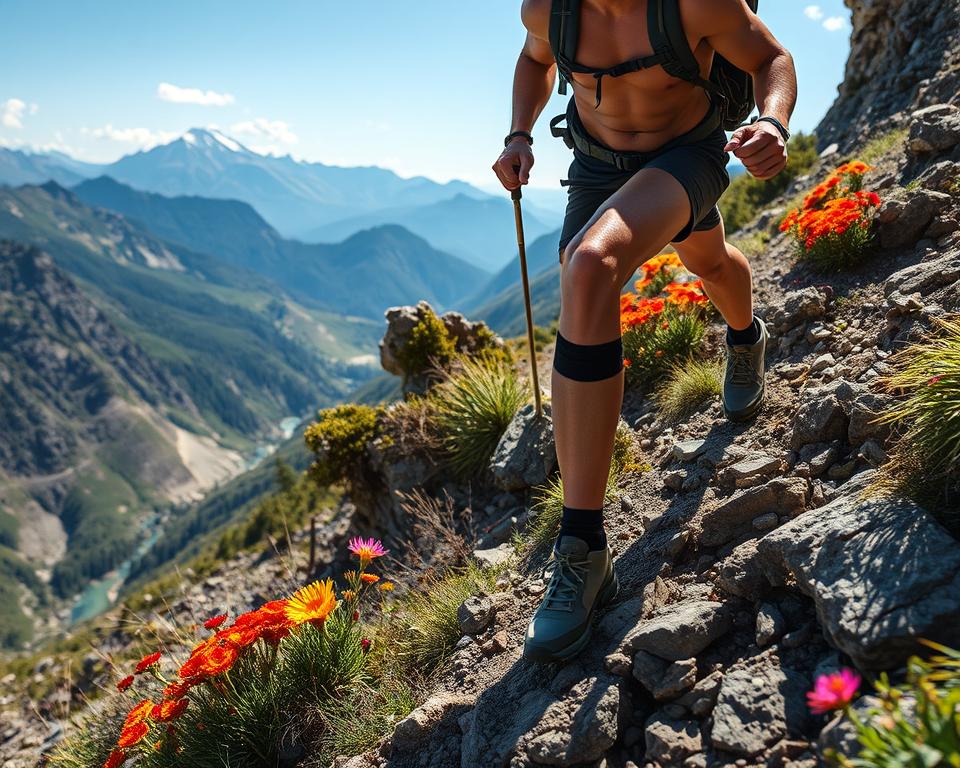Steep hiking trails demand a lot of muscle strength and heart fitness. To enjoy the amazing summit views without exhaustion, physical prep is key. Without this, the joy of reaching the top may fade due to short breath or muscle pain. Doing special leg strengthening exercises boosts speed, agility, and stamina for fitness regime for steep treks. This makes enjoying the outdoors much better.
Introduction: Why Strength Training is Essential for Hikers
As an avid hiker, I’ve found that hiking fitness routine is key for steep trails. With strength training benefits, you’re ready for anything on the trail. Hiking tough trails requires strong quads, hamstrings, and glutes.
Many believe just hiking with a heavy pack does the trick. But loaded pack walking only builds basic fitness and hiking muscle preparation. Unlike pack walking, traditional strength training benefits work muscles hard in under 10 reps.
Mixing pack walking with strength training brings out the best results. It doesn’t just boost strength; it also improves endurance for hikers. This combo prevents injuries and increases bone strength, making hikes safer and more fun.
Adding strength training to your hiking fitness routine really ups your game. Key moves like squats, deadlifts, and planks build hike-essential muscles. They make you stronger for every climb.
Before starting any new workout, including strength exercises, it’s smart to talk to a doctor. Finding the right mix of strength and hiking exercises makes trails more enjoyable. And it makes hiking less of a strain.
Goblet Squats: Strengthening Quads, Hamstrings, and Glutes
Goblet squats are great for hikers. These exercises boost strength in the quads, hamstrings, and glutes. They also play a key role in trail leg training, vital for avid hikers.
How to Perform Goblet Squats
To do goblet squats the right way, start by gripping a dumbbell near your chest. Then, slowly squat down. Be sure your thighs get parallel to the ground. Push through your heels to stand up, engaging key muscle groups. Aim to complete 3 sets of 10-15 reps or work for 30-45 seconds. Adding this to your routine will help build important muscle strength for hiking.
Benefits of Goblet Squats for Hiking
The benefits of goblet squats for hikers are clear. They significantly improve strength in your quads, helping you handle steep inclines better. Your hamstrings get conditioned, increasing stability and balance. Lastly, they strengthen your glutes and the whole posterior chain. This can lead to stronger movements and lower injury risks. Regularly performing these exercises is crucial for top-notch trail performance.
Step-Ups: Building Climbing Power
Step-ups boost your climbing power, perfect for hikers. They target key muscles like the quads and glutes. When you do step-ups on boxes, bleachers, or stairs, you strengthen these muscles. You start by lifting one foot onto the platform. Then, push up with your muscles to stand on it. Finally, step back down with the same leg.
The Barbell Step-Up is a top exercise for leg strength, especially for uphill hikes. It’s simple and doesn’t need much coordination. Plus, it’s gentle on your back, easy to add weight to, and mimics hiking movements. For good form, focus on balanced weight, a controlled step down, and keeping your knee in line.
Another exercise, the Front Squat, boosts your climbing power too. It works on your quads, core, and hip mobility. It’s safer than barbell back squats because it keeps your torso upright. This reduces the chance of hurting your back.
Don’t forget about single leg calf raises for stronger calves. These are key for pushing yourself uphill. To do them well, add weight, move slowly, and pause at the top of each raise.
If you want a full routine, try the 3-Minute Mountain Legs workout three to four times a week. It combines Single-Leg Rear Lunges and Single-Leg Step-Ups. Do 20 to 50 lunges per leg and 30 to 100 step-ups per leg. I suggest aiming for 50 step-ups and 20 to 30 lunges per leg.
Downhill Lunges: Preparing for Steep Descents
Downhill lunges are key for hikers prepping for steep descents. They help ready your quads and boost core stability. Plus, they work the muscle stabilizers needed for hiking. Focusing on downhill lunges cuts down muscle soreness and injury risk on tough hikes.
Performing Downhill Lunges
To do downhill lunges right, stand up straight with your feet apart, about hip-width. Then, step one foot forward and lower yourself down. Make sure your front knee is right over your ankle. Keep your core tight for balance and repeat the move with care. This method focuses on getting your quads ready. It simulates the conditions of going down steep trails.
Advantages of Downhill Lunges
Downhill lunges offer several benefits for your hiking prep. They build core stability and strengthen muscles needed for balance during descents. Also, they improve muscle memory. This prepares your body for the ongoing stress of downwards trails.
Adding in advanced moves like the Poliquin Step Down or deficit lunge is smart. They mimic the angles you’ll face on hikes, making training feel more real. This all-around prep guarantees you’re set to confidently face any steep descent.
Best exercises to strengthen legs for hiking
Improving leg strength for hiking goes beyond just typical exercises. Getting into leg exercises for hikers greatly impacts your trail performance. Exercises such as hanging knee raises, kettlebell deadlifts, and step-ups are crucial for getting your legs ready. They ensure your legs are equipped for the challenges of mountain paths.
Let’s dive into some effective leg workouts for hiking. These exercises are designed to boost your leg power and endurance on the trail:
- Squat Jumps: Sets: 3, Reps: 8, Rest: 20 seconds
- Single-Leg Glute Bridges: Sets: 3, Reps: 10 (each side), Rest: 20 seconds
- Dead Bugs: Sets: 3, Reps: 8 (each side), Rest: 15 seconds
- Split Squats: Sets: 3, Reps: 8 (each side), Rest: 20 seconds
- Single-Leg Deadlifts: Sets: 3, Reps: 8 (each side), Rest: 20 seconds
- Push-Ups: Sets: 3, Reps: 10-15, Rest: 20 seconds
- Leopard Crawl: Sets: 3, Time: 30 seconds, Rest: 15 seconds
- Hip Hinge: Sets: 3, Reps: 15, Rest: 15 seconds
- Side Plank: Sets: 3, Reps: 10 (each side), Rest: 20 seconds
- Shoulder CARs: Sets: 3, Reps: 3 (both directions, each side), Rest: 20 seconds
- Plank: Sets: 3, Time: 45 seconds, Rest: 30 seconds
To prep your muscles for the trail, try including these exercises in your regular routine. It will boost both leg strength and endurance for hiking.
Adding split squats and single-leg glute bridges specifically helps. They focus on your hamstrings and glutes. This gives you more stability and power for climbing steep hills and walking on rough terrain.
Cardio Considerations: The Role of Stairmaster and Hill Repeats
Getting ready for tough hiking trails? It’s crucial to add certain cardio exercises to be well-prepared. The Stairmaster and hill repeats can hugely boost your stamina and muscle power.
Using the Stairmaster for Hiking Preparation
Choosing a Stairmaster for hiking cardio is a smart move. It simulates the climbing you do while hiking. Stairmasters help enhance your heart’s health and build up your leg muscles. Start with short workouts and gradually increase them to get used to the climbing motion.
Even though Stairmasters may not target your calves as much as an incline treadmill, they’re still amazing for heart fitness. They’ll get you ready for those long hikes.

Hill Repeats: An Outdoor Alternative
Lacking gym gear? Hill repeats are a great solution for hikers. They boost your heart’s strength and get your muscles used to hiking moves. Doing hill repeats, by running or walking up and down, builds endurance. Both your heart and muscles get stronger, ready for tough climbs and descents on trails.
Adding hill repeats to your exercise plan means you’re all set for outdoor adventures. This method completes your aerobic training, making you trail-ready.
Stretching: Ensuring Flexibility and Injury Prevention
Getting ready for a hike involves more than just strength. It’s crucial to use injury prevention stretches for flexibility. Many people ask why hiking stretches are necessary. The answer is simple: they are vital for health and well-being, both now and later.
Before hiking, dynamic stretching is key. Engage muscles with leg swings and arm circles. This reduces strain risks. By doing so, your muscles become more flexible and ready for action.
Recovery doesn’t stop when the hike does. Post-hike recovery involves static stretches like those for the quads, hamstrings, and calves. They help prevent soreness and injuries, making you ready for the next challenge.
Since hiking can really impact your knees, focusing on stability is essential. Nordic curls help here. They work with glute bridges and core exercises for a full injury prevention program.
Exercises for balance and agility are also important. Try side lunges and shuffle drills. They boost your skills on rough terrain, keeping injuries away. These exercises might seem small, but they hugely impact your hiking performance.
It’s easy to start these stretching routines. Begin with simple steps then add more as you go. This way, your body stays ready and resilient, enhancing your hiking and preventing injuries.
Can Strengthening My Legs Help Prevent Sprained Ankles While Hiking Rocky Trails?
Strengthening my legs can play a crucial role in helping to prevent ankle sprains while hiking rocky trails. Strong leg muscles provide better support and stability, allowing for improved balance on uneven terrain. By focusing on leg strength, hikers can enhance their overall stability, reducing the risk of injury during challenging hikes.
Conclusion
Establishing a good hiking workout routine is key for those who want to confidently tackle tough trails. Exercises like goblet squats and step-ups strengthen muscles important for hiking, such as the quadriceps, glutes, hamstrings, and calves. These help build power for climbing and improve strength for trail challenges.
Cardio workouts also play a big role in hiking performance. Using a Stairmaster or doing hill repeats can really boost our ability to handle real trail conditions. This type of training increases our stamina, making both climbing and descending easier, with less tiredness.
It’s also vital to include stretching in our routines to stay flexible and avoid injuries. By doing exercises that build strength, stamina, and flexibility, we can enjoy hiking more and stay safe. This combination ensures we can fully enjoy the beauty of nature with confidence.

